#Convert AI text to human
Explore tagged Tumblr posts
Text
Convert AI text to human
Are you tired of artificial-sounding text from AI? Look no further than AI TO HUMAN CONVERTER. Our cutting-edge tool seamlessly converts AI-generated text into natural, human-like language, ensuring your content is relatable and engaging. Make a lasting impact with authentic communication. Experience the difference with AI TO HUMAN CONVERTER – the ultimate solution for bridging the gap between technology and humanity.
1 note
·
View note
Text
How to Use Our AI to Human Text Converter?
Are you struggling with AI-generated content that sounds robotic and needs human refinement? Our AI To Human Text converter is the perfect tool to transform AI-generated text into human-like content easily. Follow these simple steps to start converting your AI text for free:
Step 1: Visit Our Website
First, head over to our official website at aitohumantextconverter.in. No need to log in or sign up—just visit and start converting instantly.
Step 2: Paste Your AI-Generated Content
Once you’re on the site, paste your AI-generated content into the designated text box. This is the content you want to humanize using our converter.
Step 3: Select Language and Fill the Captcha
After pasting your content, select the language of the text and complete the image captcha code. This step ensures secure and spam-free usage.
Step 4: Click the Convert Button
Now, simply click the Convert button. Our AI text converter will start working on transforming your AI-generated text into a human-like format.
Step 5: Get Your Humanized Text
In just a few moments, your AI-generated content will be converted into a human-readable format. The tool uses advanced algorithms to make the content sound natural and fluent.
Step 6: Enjoy Unlimited Conversions
That's it! You can use our AI To Human Text converter as many times as you like without any restrictions. Enjoy the convenience of free, unlimited text conversion.
#AI to Human Text#AI to Human Text Converter#AI-generated content#humanize AI text#free AI to Human Text Converter#convert AI-generated text#human-readable format#AI text converter#secure usage#spam-free conversion#text language selection#image captcha code#unlimited conversions#natural-sounding text#fluent content conversion
4 notes
·
View notes
Text
Top 5 Benefits of Using AI to Human Text Converter Tools
The evolution of AI-generated content has reshaped the way we approach writing. From drafting essays to generating blog posts, AI has opened up countless opportunities. However, AI content may lack the natural flow that resonates with human readers. This is where tools like the AI to Human Text Converter come in, transforming AI-generated text into human-like language. Let’s explore the top five benefits of using AI to Human Text Converter tools.
1. Enhanced Readability and Engagement
AI-generated content can sometimes sound robotic and lack the nuances of human expression. AI to Human Text Converter tools refine this content, ensuring it reads smoothly and is relatable. This makes it perfect for websites, academic papers, and blogs, where readability and engagement are crucial. When readers find content relatable, they’re more likely to stay on the page, enhancing user experience and engagement.
2. SEO Optimization
Humanized content performs better in search engines. AI to Human Text Converters like AI to Human Text Converter optimize AI-generated text to meet SEO standards, helping websites rank higher on Google. Search engines reward content that is natural, relevant, and engaging. By converting AI text into human-like language, you’re also ensuring that your content aligns with Google’s E-A-T (Expertise, Authoritativeness, Trustworthiness) standards, leading to a boost in SEO rankings.
3. Bypass AI Detection
Many websites and platforms are now equipped with AI-detection tools. Using an AI to Human Text Converter helps your content bypass these detectors, making it appear authentically human-written. For students, bloggers, or professionals using AI-generated content, this ensures the text sounds original and relatable, without setting off alarms on content-checking platforms.
4. Multilingual Support and Accessibility
Tools like AI to Human Text Converter offer multilingual support, making it easy to convert AI-generated text into human-like language in various languages. This is a powerful feature for businesses or individuals aiming to reach a diverse audience. When content resonates across languages, it makes your site more inclusive and enhances your global reach.
5. Free and Unlimited Usage
Many AI to Human Text Converter tools, including AI to Human Text Converter, offer their services for free with unlimited use. This means you can humanize as much AI content as needed without subscription fees. Whether you’re a student, writer, or business professional, this tool is both cost-effective and efficient, giving you access to top-quality, human-like content at no expense.
3 notes
·
View notes
Text

Humanize AI Text – Best Option to Convert AI Content to Human Form
Looking for AI to human text converter? Go no further than Humanize AI Text, one of the best online AI humanizer tools ever. So, what are you waiting for? Convert the content quickly and put it on your website and get it ranked on Google top searches.
0 notes
Text

AI Text Converter To Human Form
Cudek AI is a powerful tool that converts AI-generated text into human-readable format specifically optimized for users in the UK. For more details, please visit https://www.cudekai.com/convert-ai-text-to-human
0 notes
Text
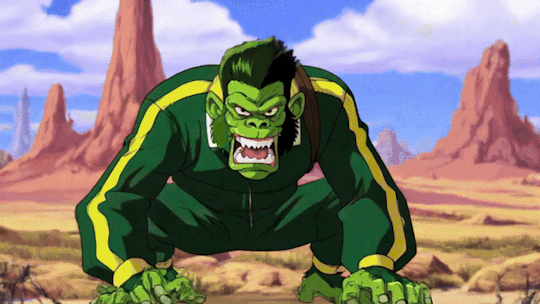
Vidu 2.0 - First Reactions
I am in the Vidu Artist's program, so I've had a chance to play with version 2.0 before the official launch on the 15th. What I'm working with is a pre-launch build, and has improved day-to-day, so this may not reflect the final release.

I haven't yet had a chance to give it the full paces-run-through it deserves, but here's some early samples, and early thoughts. (Converted to GIF because you can only upload one video per post.)
The short version is that everything has been incrementally improved: Better coherence, better prompt responsiveness, better motion, and way, way better speed. Without doing exact time-tests it's say it's at least 25% the time to generate a video of the same dimensions.


While there's still some of the "smudge-blurring" that you got with 1-1.5, it happens less frequently, and is more mitigated with an image/animation that match.


Motion varies gen-by-gen, but impressive results seem to be the norm.

While his sticks are somewhat flexible at full framerate, the cat drummer's cymbal hit struck me as particularly nice.
Control and Coherence

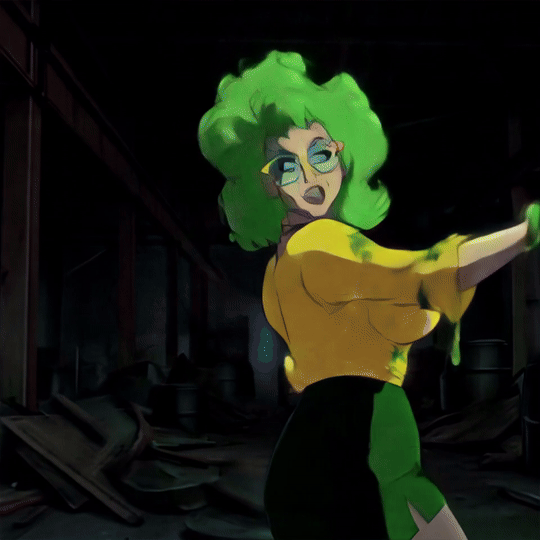

While the roar may not seem particularly impressive, roars, howls, and other emotional outbursts didn't work well in previous versions. Aunt Acid's fumes and drips are are particularly fun, and while it still has problems with her tail, PteroDarla's crest and wings are actually working the way they should (after a number of attempts).

For a long time, I've wanted the last shot of the TMax opener to be Max starting with a zoom-in on the eye going out to a roar and pose. While this isn't quite where I want it, 2.0 is the first time I've gotten him to go through the whole sequence. Which is promising.
Weird Stuff Works
What remains impressive about Vidu is how well it handles concepts and characters that are off-the-beaten-path. Hailuo just released a character consistency feature that only works with humans, but here...

Here's my friend Cole's OC, the Waffler (Intergalactic Bounty-Hunter.) He's one unbalanced breakfast. He's also rather resistant gen AI replication because he's an SD space man with a waffle for head, a very specific waffle for a head turned at a 45 degree angle. Vidu 1.0 wasn't able to work with him, almost always giving him a mouth or rotating his waffle, if not completely glitching out. 2.0 is much better to handle it.
The numerous dino-anthros above are all in the "Tricky for AI" box. If I was into doing what could be gened easily, however, I'd just be pumping out an endless parade of pillowy waifus.


In my defense, I classify SexBomb as more of a 'strifu'. This particular one was an attempt to see if a toony image prompt could be rendered live-action with text prompting. Long story short it can't, but it can produce some interesting effects like the faux-posterized background.
I've had AI gen close to her costume before, but it never adds the fuse or does the boob-window right, and here we are.
One of my old bits of Transformers fanart of the Pretender Monster Icepick served as the character model for the one on the right.
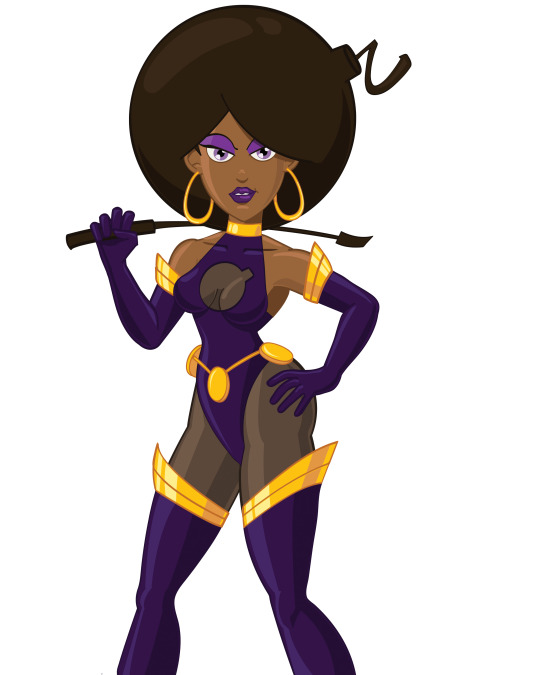
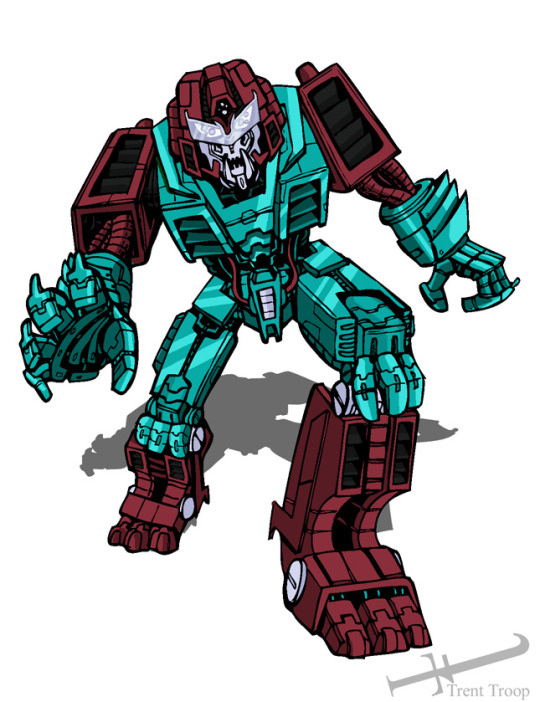
Fantastical Creatures in general are a lot easier to execute in this version as well.


And... Action!

Motion is a lot more natural this time around.


Weapons fire (though sometimes a bit literal) tends to come out of the barrel semi-consistently now, characters can fight the waves without melting themselves and...
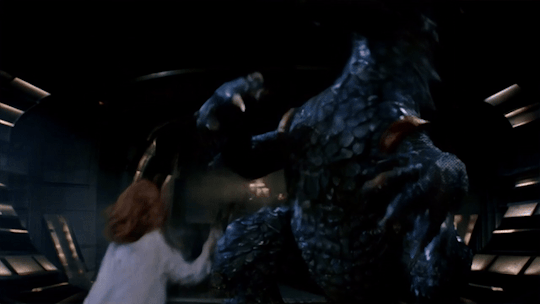
A giant rubber monster can eat your protagonist (if you're lucky.)
Quirks and Flaws
Nothing is perfect, and all AI you see is curated. So lets talk areas to be improved.


A lot of stuff presently generates with multilingual gibberish captions sometimes, which I expect is an early model bug. Versions 2-3 of Midjourney would have similar artifacts, and that sort of thing isn't hard to correct for.
There are still issues with blurring/smudging, especially with things like tail-tips, hands, and any motion the robot doesn't quite get.

Sometimes stuff shapechanges or appears that ought not to, like the knight's floppy second blade.

Or speed gets off requiring being fixed in post.

And stuff just goes dumb sometimes, which one should expect (and in my estimation, desire) from any generative system, artificial or analogue. Should the water go on the fire rather than the firemen? Yes. Do I regret this gen? No.
One quirk of the system is how it resolves incongruous multi-prompts. I've been accustomed to Midjourney, which, when generating an image must blend everything requested. You can put two completely different backgrounds in as image prompts and it will blend them into something new and wacky.

Vidu resolves problems like having two background images at once by taking advantage of the 4th dimension. Confuse the robot too much and it will just cut/fade from one idea to the next.

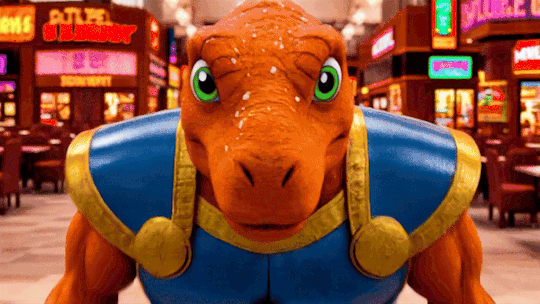
And then there's stuff that just happens, like, a shot being perfect except a painted (and thus ought to be static) background object animating beautifully (going retro is a path wrought with irony) and the robot deciding it'd rather do CG-style than 2d.
And while it doesn't show up great in the gif of Max at the construction site there, 2.0 is more vulnerable to interpreting bad transparency-clipping as part of the character design, so be careful if you're using transparent PNGs.
Also, if you slap a character and a background together without elaborating on the setting with the text prompt, it will often slap the background back there as a static backdrop and produce a very "greenscreen-y" effect.
Rather than laden this post down with more animated GIFs, I'll be setting up a batch of them as posts for the upcoming days. At least, that's the plan.
#vidu ai#vidu#vidu speed#vidu 2.0#ai video#ai animation#tyrannomax#AI tutorial#AI review#animated gif
74 notes
·
View notes
Text
For those looking to have fanfiction read to them: we have the technology.
Utilising ao3's download function and a TTS (text to speech) robot, you can have any fic read to you. This IS a different experience to listening to a podfic, and you're not likely to find a 1:1 human sounding voice for this, but you will very much have a fic read to you. If this kind of assistive technology will help you out, please use it. That's what it's there for. You don't have to be ticking any kind of disability box to use it.
AI doesn't need to be involved. You can search ao3 as you normally would, download the fic (in epub format ideally), open it in your ebook app, and have your TTS read it to you. Google search "ffn to epub" to find sites converting fanfiction.net links to epub format (other formats are usually available as well).
I have an android phone, and I use:
Librera PRO ebook reader - you can use the free version, Librera, if you don't want to pay/want to try it out first. I use this app every day, and since it is a one time purchase, it was very worth it to buy. This app has hands down the best performance when it comes to integrating TTS functions into its ebook reader that I've experienced.
Acapela TTS voices - these are BOUGHT voices. The TTS most devices come with is, uh, bad, so when I wanted to listen to multiple hours of TTS reading, I decided to buy. Acapela has a wide range of voices in various languages and accents. The basic ones (ideal for reading you a story) cost 3.99 €
This post is not about podfic, which is an entirely different thing, but it is also not NOT about podfic. There are more podfics out there than you may realise: fics performed by human artists, recorded, edited, and uploaded to the internet for your listening pleasure. If you prefer an audio experience and the fic you want to read has a podfic available, why not give it a try!
55 notes
·
View notes
Text
"I have seen three pictures of the man".
Picture_01
The boy stood still, staring at the camera, his gaze fixed, unyielding. A absent smirk, just the stark, unadorned plane of his face. It was a face that already knew the weight of scrutiny, the silent judgment that settled like dust. No empathy, but a rigid mask, the skin stretched taut over the bones, revealing nothing.
"What a dreadful child!", a silent testament to the cruelty of first impressions. "What a hideous little boy! A monkey! That's why he looks so miserable and nobody wishes to play with him.". Parents would quietly whisper to each other upon seeing him arriving at the playground, shamelessly blessing God for having not so ugly sons.
Even in childhood, the contours of our features are being etched into a narrative not of our making. A single, unyielding look, and the world begins to define us: dreadful, wizened, hideous. Labels whispered and solidified, a prison built of glances. How swiftly the gaze of society could strip innocence, how easily a child could become a stigma, a grotesque caricature, simply for the way he appears, and becomes no longer human.
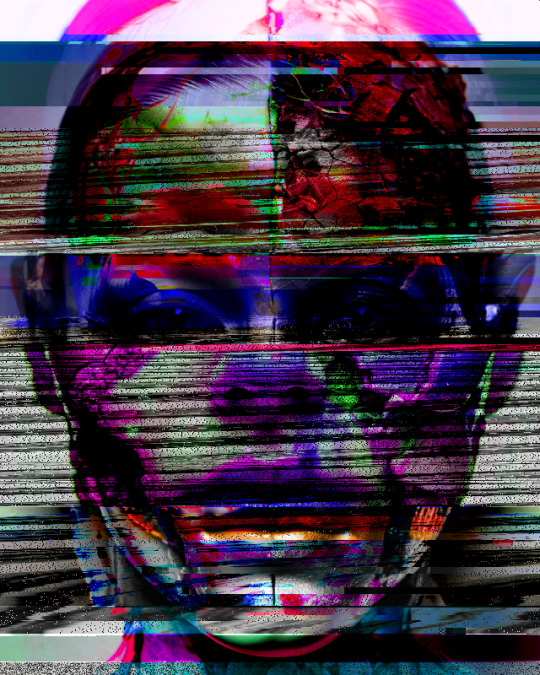
#GlitchArt + #AIportrait + Text inspired by a paragraph from No Longer Human by #OsamuDazai.

Childhood and Body Shaming.
Society's judgmental and pitiful gaze.
Physical appearance and discrimination.
Art inspiration and creative process.
Experimental Art and New Media.
Body Horror and Body Positivity.

How was the video made?
Initial AI Image Generation and Glitching:
Eight AI-generated portraits were compiled into a PDF (JPG compression).
The PDF's raw data was manipulated using a text editor (Notepad++) by replacing hexadecimal characters, creating initial glitches.
The glitched PDF was viewed in SumatraPDF.
Each glitched image was copied and pasted into a single Photoshop file as separate layers (PSD).
The PSD file's raw data was again manipulated in Notepad++, further glitching the image layers.
The glitched layers were then adjusted in Photoshop using Hue and Saturation adjustments.
All layers were blended into a final PNG image.
Image Sorting and Animation:
The PNG image was processed using the "UltimateSort" script by GenerateMe, creating a series of sorted frames.
A selection of these frames was exported.
The frames were compiled into an animated GIF.
The GIF was encoded into an MP4 video.
The GIF's raw data was databended in Note++
The glitched GIF was played in IrfanView and screen recorded via ShareX.
The two MP4 video files that were made from the GIF were edited together in Adobe Premiere.
Video Glitching and Audio Integration:
The edited video track was exported as an MP4.
The MP4 was converted to an AVI file using the ASV1 codec.
The AVI video's raw data was imported into Audacity as a RAW file, glitched, and saved.
The glitched AVI was converted back into an MP4 video using FFmpeg.
The glitched video was imported into Adobe Premiere.
Audio was added: a Mubert-generated musical track and a voiceover.
The voiceover was created using TTSMaker, based on text generated by Gemini 2.0, which drew inspiration from a paragraph in No Longer Human.
#digital art#new media art#artificial intelligence#glitch art#glitch#art#artists on tumblr#databending#dark art#macabre#dark aesthetic#dark artwork#glitchart#glitch aesthetic#glitchartistscollective#glitch artists collective
13 notes
·
View notes
Text
Digimon & mythology: angel Digimon
The Digital World is a dangerous place, with plenty of demon lords, monsters, and villains just waiting to unleash their power. But there is light to counterbalance the darkness and the ranks of the angel Digimon will fight back against evil. The angels of Digimon are based on Christian angelology, the theological study of angels form a Christian viewpoint. Christian angelology is of course based on the older Jewish angelology, but Digimon pulls much more from the Christian version. Christian angelology traditionally has a hierarchy that appears to have been invented by the 5th century author, theologist, and philosopher Pseudo-Dionysus, who mixed existing beliefs about angels with neoplatonic philosophy to create his hierarchy. The name Pseudo-Dionysus is because he identifies himself as Dionysus to try to portray himself as a character of that name from the book of Acts, but modern scholars generally agree that even if the guy from Acts existed (debatable given the heavily fictionalized nature of Acts), the author wasn’t him. The hierarchy of angels is usually given in three spheres consisting of three ranks each. From lowest to highest they are angels, archangels, principalities, powers, virtues, dominions, thrones, cherubim, and seraphim. Most angel Digimon are associated with one of these ranks, though some fall outside of this system. I’ll give more context on each rank as they come up.
Like in the original mythology, angel Digimon answer to God. What God is in the Digital World is very vague and inconsistent across the different entries in the franchise. Most of what we get is that it’s a being of goodness that rules the angel Digimon and wants what’s best for the Digital World. In different parts of the franchise, God has been identified as a human programmer, Huanglongmon of the Holy Beasts, and as the computer system that the Digital World exists with. More modern takes on the franchise have an AI computer system named Yggdrasil as the ruler of the Digital World, which fills the role of God, but is usually not depicted as being a purely benevolent being. In fact, Yggdrasil tends to be a villain whenever it shows up. God also dwells in the kernel. The kernel is the core of the Digital World and location where all the data is computed, yet it may also exist in a higher dimension above the Digital World. All angel Digimon come from the kernel and live there when they aren’t sent out on missions. The kernel is very much supposed to be the heaven of the Digital World, though in an earlier sense of what heaven was supposed to be. In the oldest forms of Judaism, heaven was the dwelling place of God and the angels, but wasn’t an afterlife. Instead, all humans went to Sheol, a poorly described state or place, regardless of what they did in life. It wasn’t until the second temple period after the Persians conquered the Babylonians who had themselves conquered the Hebrews that the idea of a divided afterlife entered Judaism, one of many idea adopted from the Persian religion of Zoroastrianism. Heaven was converted into the good afterlife, expanding on its previous role as God’s home. The kernel doesn’t act as a Digimon afterlife because Digimon reincarnate in most settings.
I will discuss each angel Digimon, going from Child/Rookie to Ultimate/Mega levels. While God operates through more Digimon than just the angel Digimon, including Sakuyamon, Kuzuhamon, Kongoumon, and maybe Shakamon (if God = Yggdrasil), I will only be going over the angels because this post is going to be long enough already. Most demonic Digimon are either implicitly or explicitly fallen angel Digimon. If one of the angel Digimon has a specific fallen angel counterpart I’ll mention it, but I won’t be going into detail on them. It is worth noting that almost all the angel Digimon are based on the winged human depiction of angels. Angels in the texts of the Abrahamic religions are instead described as completely bizarre beings, usually with way too many eyes (though at least some of them can choose to appear human). The winged human depiction was popular by at least early Christianity, with the earliest known depiction being attributed to the 370s-390s BCE. Given that Digimon are born out of data generated by humans, it’s likely because the winged human depictions are so popular that angel Digimon also take that shape.
The lowest member of the angelic hierarchy is the only Child/Rookie level angel, Luxmon. Luxmon was only introduced earlier this year so it doesn’t have much lore, but it does act as a great starting point for any angel Digimon line. It is so pure and innocent that it doesn’t realize when it’s being lied to, which means demonic Digimon of its level like Impmon and PicoDevimon/DemiDevimon will bully it. Like other members of its level, Luxmon is not very powerful, but they can fight against strong foes by using teamwork. Angel Digimon are often depicted as being stronger than the average member of their level. Luxmon is clearly designed to look like a younger Angemon and it worked. I think it’s a good design that captures both the angel aspect while also making it look like a little kid.

In the Adult/Champion level, we have Angemon. I believe it is the first angel Digimon in the franchise and the one on which all others are ultimately based. It is a being of virtue that brings happiness, though it is also relentless in the battle against evil. Each angel Digimon has a certain role in the angelic hierarchy and Angemon’s job is to lead other angelic Digimon in the fight against evil. It wields a quarterstaff called the holy rod. An Angemon who falls becomes a Devimon, which retains its role as a leader, it just leads evil Digimon instead of good ones. Angemon’s design is a classic and a great example of a Digimon that just looks like a human in a costume, but still feels different. Angemon is likely the most powerful of the Adult/Champion level angels and is often depicted as being far more powerful than its level would indicate. This is especially true in Digimon Adventure, where it was easily capable of beating Digimon a whole level higher than it.
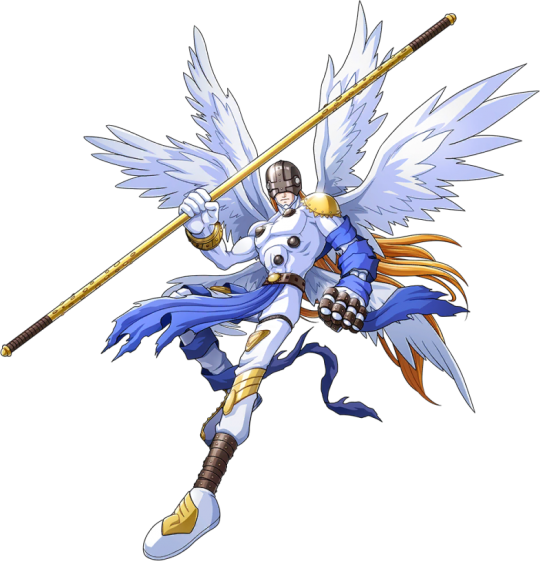
Pidmon is a variant of Angemon that ranks lower in the hierarchy, but is of similar power. Its design is a recolor of Angemon with a different staff and only one pair of wings. Many of the angel Digimon’s lore states that the number of wings an angel Digimon has indicates its rank in the hierarchy so the two-winged Pidmon ranks lower than the six-winged Angemon. This is not a hard and fast rule, as multiple angel Digimon have fewer wings than their rank would indicate. Pidmon’s role in the hierarchy is to destroy evil, presumably making it a major member of the forces that Angemon leads. Its name comes from Cupid, the Roman god of desire, attraction, affection, and erotic love. While a roman god seems like an odd inspiration for the very Christian-inspired angel Digimon, there could be a roundabout reference here. The winged baby statues that are often called cherubs are actually called putti and depict Cupid. Somewhere along the line some wires got crossed and the name of a rank of angel got applied to the putti statue.

Darcmon is the last angel of this level and the fort one to appear feminine. Its four wings presumably place it between Pidmon and Angemon. It is heavily combat focused and takes the role of vanguard and advanced force in the angel army. Given their descriptions we can get an idea that in the angel army Pidmon make up the majority of soldiers, Darcmon are the advance fore that go straight to the front lines, and Angemon are the leaders. Darcmon is a reference to Jeanne D’Arc, better known to English speakers as Joan of Arc. She was a 15th century French military leader who claimed to receive visions from angels and saints. She was convicted of heresy and executed, but the Catholic church later revoked the conviction and declared her a saint. She referred to herself as la pucelle, the maiden, which became the name of one of Darcmon’s attacks. I think Darcmon is severely underutilized for how cool her design is as far as I know, she has two anime appearances, one of which wasn’t actually a Darcmon but a villain in disguise.
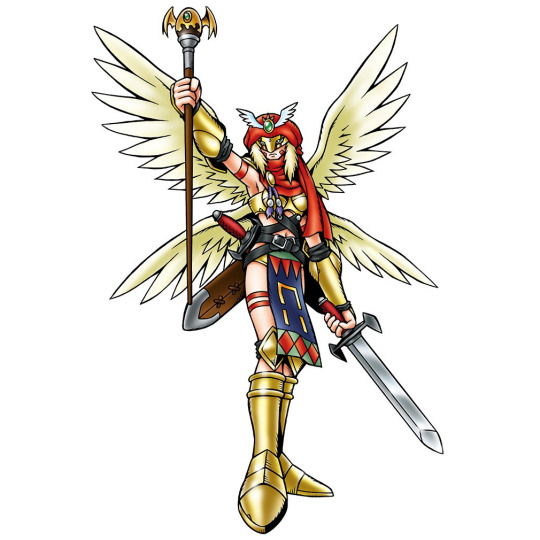
Luxmon, Pidmon, Darcmon, and Angemon are all classified as angel Digimon, which equates them to the lowest rung of the traditional hierarchy. Angel is used both to refer to the beings as a whole but also the lowest rank in the hierarchy. Their role it to act as announcers. They appear is scriptures to make various announcements, usually to humans.
The first angel Digimon of the Perfect/Ultimate level is HolyAngemon, renamed in English to MagnaAngemon. It has eight wings, placing it above Angemon. It has two forms: its regular form and HolyAngemon Priest Mode, which have different roles. Overall, HolyAngemon acts as the law enforcement of the angels, supervising and surveying the others to keep them within the bounds of their missions and try to catch any who fall. HolyAngemon Priest Mode is said to be the from it spends most of its time in. In this form, it spends its time acting as a spokesperson for God and goodness in general. When darkness arrives, it changes into its combat form to take up arms against evil. Ironically, despite Priest Mode being the form it’s supposed to spend most of its time in, this form is almost never seen in Digimon Media, being a long-time inmate of V-Tamer jail. HolyAngemon bears the sword Excalibur, an obvious reference to King Arthur.
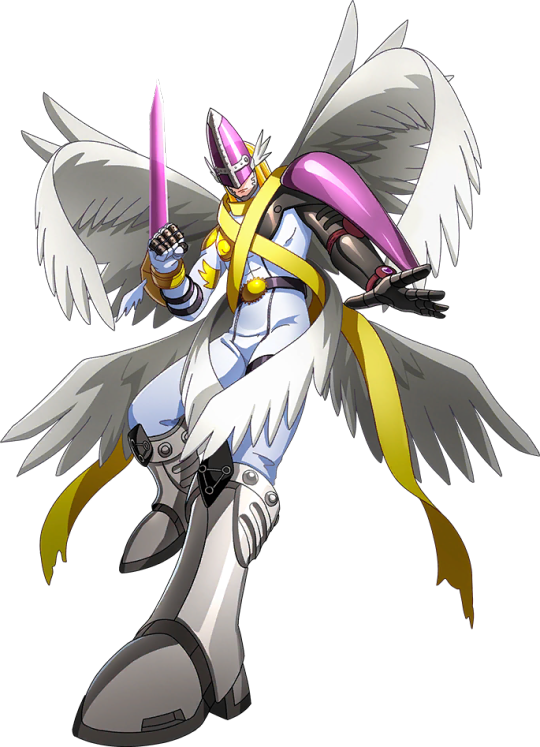
HolyAngemon
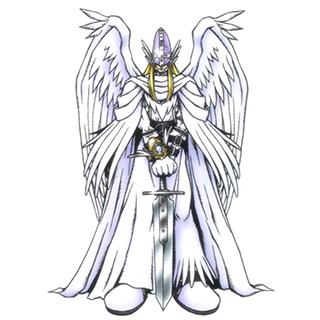
HolyAngemon Priest Mode
Next is Angewomon, who also has eight wings. She is a being of utmost beauty with an extremely kind personality. Her role is to try to redeem evil Digimon. By showing kindness and grace, she can bring Digimon back from the path of evil. However is a Digimon cannot be redeemed, she will attack and show that she is an extremely powerful combatant. She is often depicted as being equal in power to HolyAngemon A fallen Angewomon becomes a LadyDevimon, who is as cruel and wicked as Angewomon is kind and benevolent. The two species despise each other. Angewomon is one of the most popular Digimon for a very good reason. Her design is a classic and stands out among all the other “sexymon” designs out there. Angewomon has an x-antibody form which is fine. It’s overdesigned and unnecessary, but if that’s all I can say about an x-antibody form, it’s one of the good ones.

Angewomon
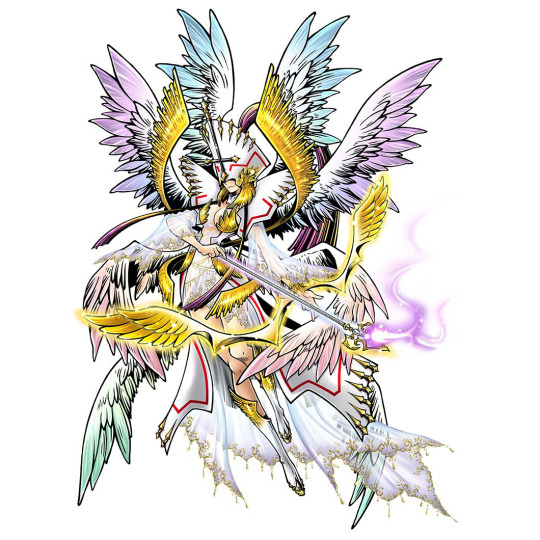
Angewomon X
HolyAngemon and Angewomon are both classified as archangel Digimon. Archangels are the second lowest in the hierarchy and their job is to make declarations. The idea of archangels being the highest rank of angel seems to come from the epic poem Paradise Lost and confusion over the name. “arch-“ means “chief” or “first” so people mistakenly assumed that the chief angels were the highest rank. Despite this, Michael (who is explicitly an archangel and the only one ever called that in the bible) is often seen as God’s second in command even by clerical sources, furthering the confusion. A very common idea is that there are four or seven archangels with different names and roles. Michael, Gabriel, and Raphael are almost always among their number, but the identities of the rest vary depending on tradition. Worth nothing is the Digimon Bagramon, a former archangel. He ruled over death in the Digital World before rebelling and falling. This would equate him to the angel of death, a figure who transports the souls of the dead to the afterlife and is usually named Azrael.
Also at the Perfect/Ultimate level is ArkhaiAngemon. It is of equal rank to HolyAngemon and Angewomon and does have eight wings. Unlike its fellows, ArkhaiAngemon is a more defensive and support fighter, allowing it to protect its subordinates and command them in battle using ingenious strategies. ArkhaiAngemon is driven by a concern for others, which leads it to interact with other Digimon more than its fellows. It frequently employs non-angel Digimon as familiars who fight on its behalf. It wields its own version of Angemon’s holy rod, which can release a flame that alternately harm and protect. While being of equal rank to HolyAngemon and Angewomon (and its name being a corruption of “archangel”), ArkhaiAngemon is identified as a principality, the rank above archangel. Their job is to guide and protect organizations, whether they be nations, groups of people, or other institutions. This fits with ArkhaiAngemon guiding and protecting its subordinates.

At the Ultimate/Mega level, we have SlashAngemon, a badass angel made of swords. It is the leader of the angel army and the ultimate military commander of the angel Digimon. It is stern and serious and cuts down evil without hesitation. It has 8 wings, but this is the level where the wings = rank thing starts breaking down.

Another militant angel of this level is LovelyAngemon. She is a cheerful and fashionable angel whose cuteness and charm belies the fact that she is the foremost close combat expert amongst the angel Digimon. It has the data of multiple styles of martial arts within its code, making it a martial artist is extremely powerful punches. Interestingly, LovelyAngemon has no wings.
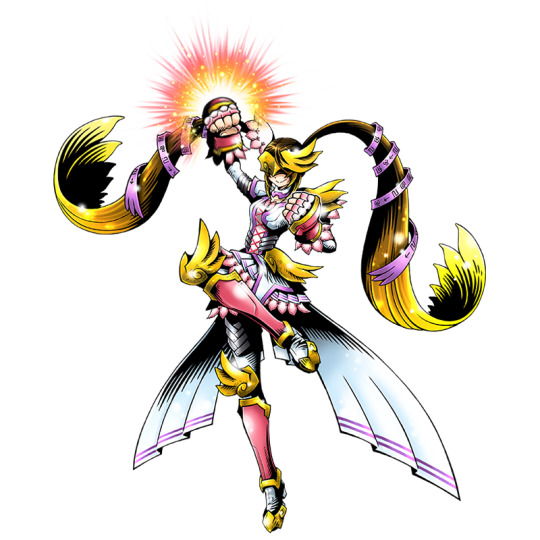
SlashAngemon is identified as a power, the rank of angel above principalities and the first of the second sphere. They are granted the power over evil forces, restraining demons from hurting humans. They also oversee human authorities such as kings. The power over evil thing fits SlashAngemon. As the leader of the angel army, it is the one who commands the fight against evil. LovelyAngemon is not identified with any rank of angel, but given she is a combat specialist, I would guess she’s heavily involved in the fight against evil and is therefore likely a power.
ClavisAngemon bears a key called the key (very original) which can unlock any lock in the Digital World. Only ClavisAngemon can use the key and it appears that the angel is part of the key rather than a separate being holding it. ClavisAngemon’s duty is to guard the zenith gate, the gate that separates the Digital World from realms beyond. As the kernel is in a higher dimension than the Digital World, it would seem that ClavisAngemon guards the passage to the kernel and only lets angel Digimon through. It can bring the entire power of the Digital World down on an enemy that tries to break through the gate. ClavisAngemon has six wings and is identified as a virtue, the rank above powers. Virtues are supposed to govern over the elements, bring natural events like storms and wind. They are also associated with movement and assist in creating miracles. There isn’t much of a connection to ClavisAngemon, but it may be related to another story. In the Adam and Eve story, after the two are ejected from the garden an angel is assigned to guard the entrance and prevent them from getting back in. That sounds more like ClavisAngemon’s role than anything else. Clavis is Latin for “key” so the Digimon named key carries a key named the key.

Next up is Dominimon and Games Workshop is looking at those pauldrons with envy and fear. It falls outside of the angelic chain of command and is a rare being that only appears when the balance between light and darkness is severely disrupted. Its purpose is protect other angel Digimon and destroy evil at all costs. It has no sense of self-preservation and will throw itself into deadly situations or use a special move to empower other angel Digimon at the cost of its own life without hesitation. Because of how rarely one appears and their self-destructive tendencies, very few have ever actually seen a Dominimon and many think they are mere legends. It wields the sword Final Excalibur, a powered-up version of HolyAngemon’s Excalibur. Despite falling outside of the angelic chain of command, Dominimon is identified as a dominion, the rank of angel above virtues and the last of the second sphere. Their purpose is to govern the motions of stars, planets, and other celestial objects. Not a whole lot of connection to Dominimon there. Dominimon has ten wings.
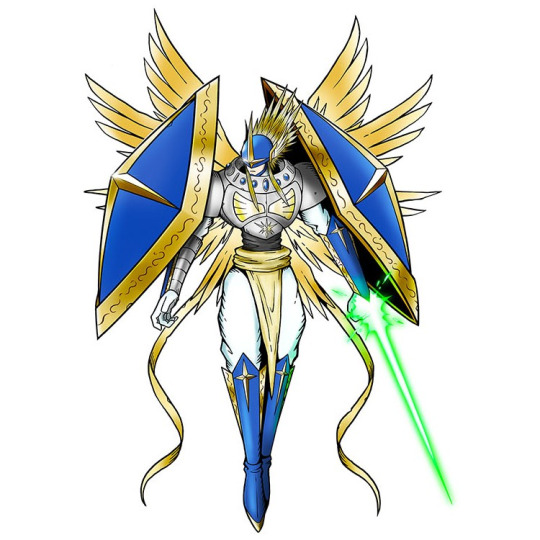
Another angel Digimon that doesn’t follow the normal chain of command is Mastemon. It is an anomaly that is a fusion of an Angewomon and her fallen counterpart LadyDevimon, making her a living enemies-to-lovers lesbian relationship unprecedented merging of light and darkness that only appeared when the Digital World faced a threat so great it forces angel and fallen angel Digimon to work together to stop it. While firmly benevolent, Mastemon commands both holy and evil powers and can command both angel and fallen angel Digimon. It is a master strategist and only it uniting the forces of good and evil saved the Digital World from that unspecified threat. Mastemon does not correspond to any mythical rank of angel and has 12 wings, half white and half black. This is a clear reference to Lucemon, who was the greatest of the angel Digimon before falling and becoming the greatest of all demon lords. Lucemon also has 12 wings that are half white and half black. In his case, this symbolizes him being trapped between his original benevolent self and his new evil self. Lucemon and Mastemon are both angelic being between good and evil, but Lucemon is malevolent while Mastemon is benevolent. I don’t think there’s been any media comparing the two, but it’s a great story idea. The name comes from Mastema, a demon or fallen archangel in some Jewish texts identified as a bringer of disaster and evil. I suppose there’s some connection with Mastemon only existing due to a disaster, but it’s tenuous.

This too is yuri
Rasielmon is the first angel Digimon to not just be a winged human. She’s still mostly human, but with some cat-like features. It once held the same rank as the more powerful Ofanimon, but no longer does for unknown reasons. Rasielmon resides within the kernel and has the power to foresee anything in the Digital World as long as it remains there. This makes it one of the most knowledgeable Digimon. It commands the godai, the five elements of Japanese Buddhism: earth, fire, water, wind, and void. Rasielmon also has an attack called Sefer Raziel, named after the Kaballah text Sefer Raziel HaMalakh. This text claims to teach magic and cites Raziel, angel of secrets and a teacher of wisdom, as the most powerful angel. Rasielmon being based on an angel associated with secrets and knowledge certainy fith with it being able to see the entire Digital World. If Rasielmon falls, she becomes Raguelmon. Raguelmon was shunned for its knowledge and became a nihilist. It still seems to care for angel Digimon in a twisted way as it can sense when an angel Digimon is close to falling and will try to prevent it by killing them first. Raguelmon is named after Raguel, an angel of justice who keeps demons in check. Raguelmon’s actions can certainty be seen as a twisted version of justice and preventing of evil.

Rasielmon

Raguelmon
We have reached the top, the zenith of the angelic Digimon, the Three Archangels. These three are the most powerful of all angel Digimon, charged with enacting God’s will and guarding the kernel from all who would threaten it. The first of the three is Ofanimon (English: Ophanimon). She is the ultimate form of feminine angel Digimon and her duty is to impart God’s love on the Digital World. It nurtures and protects other Digimon and wishes to see them do good, but it can and will fight against evil. It has 10 wings. Ofanimon has an x-antibody form which is pretty good as far as x-antibody forms go, but still overdesigned. If Ofanimon becomes enraged at the seemingly-endless amount of evil in the Digital World, it will become Ofanimon Falldown Mode. It has closed its heart and become a dark avenger, nipping evil in the bud by attacking Digimon with the potential to become evil. It seeks to establish a world of absolute justice where evil is destroyed before it has the chance to take root. An Ofanimon who falls even further will become Lilithmon.

Ofanimon
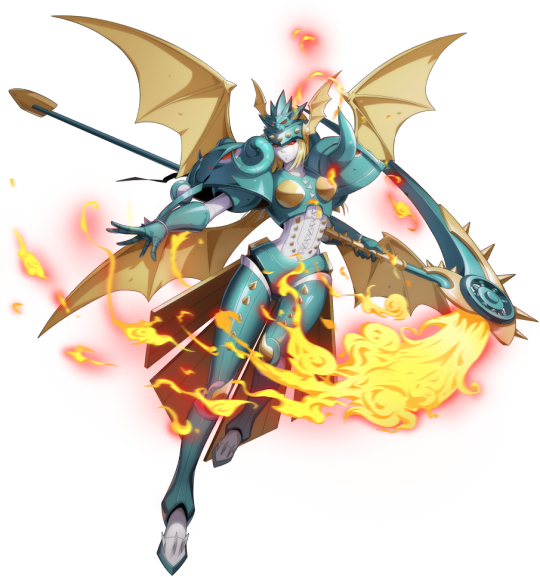
Ofanimon Falldown Mode Mommy? Sorry, mommy? Sorry, mommy?
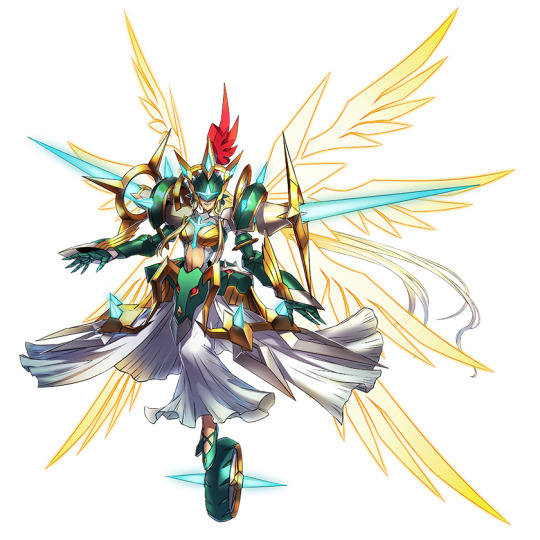
Ofanimon X
Rasielmon and Ofanimon are both classified as ophanim, the class of angel above dominions. Also called thrones, they serve either as the wheels of the throne of God, or the throne itself. They are also charged with chanting glorias and maintaining the harmony of universal laws. These guys are the classically weird biblically accurate angels. They are depicted as flaming wheels within wheels covered in eyes. The idea of gods having wheeled thrones was common in the ancient Middle East, with multiple cultures depicting their gods seated on such. Ofanimon bears no resemblance to a wheel, but her shoulder pads take the shape of wheels and Ofanimon X balances on a wheel.
Next is Cherubimon Virtue, which is the only fully non-human of the angel Digimon. It looks instead like a humanoid rabbit with no wings. It is the ultimate holy beast and its duty is to protect and impart God’s wisdom. Because Cherubimon Virtue stands at the zenith of divine virtue, it is easily stained by the inverse and can fall to become Cherubimon Vice, a thoroughly evil creature that embodies sin and wickedness just as its Virtue form embodies the opposite. Both forms can call down lightning as a form of divine judgement. Cehrubimon is based on the cherubim, the rank of angel above the ophanim. Their role is to accompany God when he travels. Cherubim are another bizarre-looking angel and while they don’t look like rabbits there is an association with animals that fits Cherubimon being a holy beast. Cherubim have four faces: a human, an ox (representing domesticated animals), a lion (representing wild animals), and an eagle (representing birds). They also have four wings, four arms, hooved legs, and are covered in eyes. Frankly, one of those would have been a lot cooler as a Digimon than a big rabbit. There is a reference to the faces of the cherubim, but it’s in Ofanimon not Cerubimon. Her helmet has the heads of the three animals on it. Both forms of Cherubimon have x-antibody variants which are classically x-antibody. That is not a compliment.
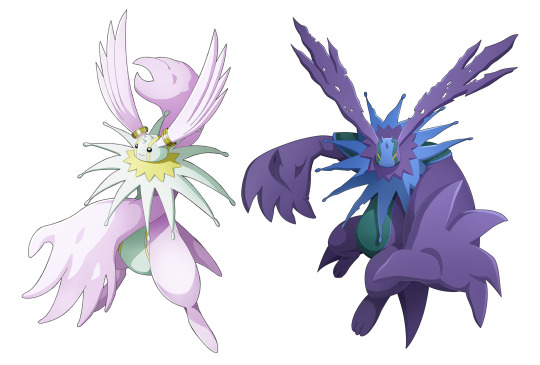
Cerubimon Virtue (left) and Vice (right)
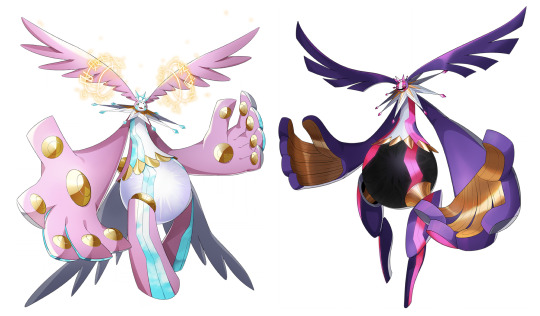
Cherubimon Virtue X (left) and Vice X (right)
The final angel Digimon is Seraphimon. It returns to the winged human design, but is entirely covered in armor and has 10 golden wings. It is the most powerful of the angels and the closest of all Digimon to God. As the highet-ranking angel, it is the one ultimately in charge of all others. It is also the ultimate masculine angel and its duty is to enforce Gods laws. Legends say that when the final battle between good and evil comes, Seraphimon will descend to the Digital World and purify everything. Its ultimate ability is to sacrifice its life to restart the world. If a Seraphimon becomes overwhelmed with resentment it will become a BlackSeraphimon (English name: ShadowSeraphimon). It is still redeemable in this state, but if not redeemed in time, it will fall and become a Demon (as in the Digimon named Demon, not just some demon). Seraphimon is based on the cherubim, the highest rank of angel in Christian Angelology. Their role is to stand around the throne of God chanting “holy, holy, holy” and are also charged with anointing. The word “seraph” means “burning” and was often used to describe snakes (possibly referencing the burning sensation of snake venom). As a result, seraphim are often depicted either as snakes or as being on fore or made of fire. All depictions give them six wings, which are sometimes used to cover their body to protect humans from seeing their power. Seraphimon covering its entire body with armor could be a reference to this. Seraphimon being the ultimate masculine Digimon to Ofanimon's ultimate feminine Digimon could be a reference to systems like Kabbalah and some forms of Gnosticism assigning different magical powers or holy virtues to males and females.

Seraphimon
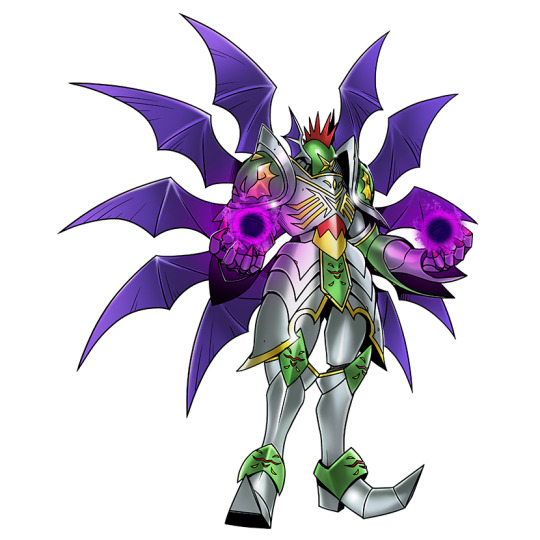
BlackSeraphimon
#digimon#mythology#christian mythology#jewish mythology#angelology#angel#archangel#luxmon#angemon#pidmon#darcmon#holyagemon#magnaangemon#angewomon#arkhaiangemon#slashangemon#clavisangemon#lovelyangemon#mastemon#dominimon#rasielmon#raguelmon#ofanimon#ophanimon#cherubimon#seraphimon#ofanimon falldown mode#blackseraphimon#shadowseraphimon
112 notes
·
View notes
Note
What do the sistermon’s do all day? Is it akin to nuns in the human world?
A very amazing question that’s gonna be text based! (I’m sorry)
The thing is, the religion is a blend of Buddhism and Christianity. As Digimon is a huge blend of cultures, so the religion had to adapt.
Sistermon Pray to a Trinity; The Destined (their version of the father, Humans who maintain the game), The Revered (“son” in this case, the AI like Yggdrasil) and the Holy Angels (the Holy Spirit, the 4 main angels who do everything )
Tinge, Cerulean and Meri are all pretty new nuns, so they’re not forced to wear their habit outside of “hey important people are here, please be respectful”.
While Joan and other nuns/angelic digimon of her rank are required to wear habits, keep their outfits restrictive and have short hair.
This also means their duties just depend on their rank and Level
Meri is a Rookie level so she’s expected to study, learn the prayers and clean up.
Tinge and Cerulean are both Champion level, but they’re teenagers so their duties tie more to outside the church. (Hunting, Cleaning the outside, maintenance of the church and driving out any feral digimon.) it’s mostly to let them release steam, as Digimon (even humanoid ones) are still like,,, animals/monsters, and if they don’t hunt and get that energy out they might roughhouse too much.
Joan is expected to: Lead Crusades, Lead prayer, Watch over orphaned children, convert others to the religion, maintaining bonds and such. Her jobs are the most like a typical nun, however with a “yeah this is a monster catching game” flair.
So most of the time the sistermons and Joan will be busy with religious stuff, hunting and training.
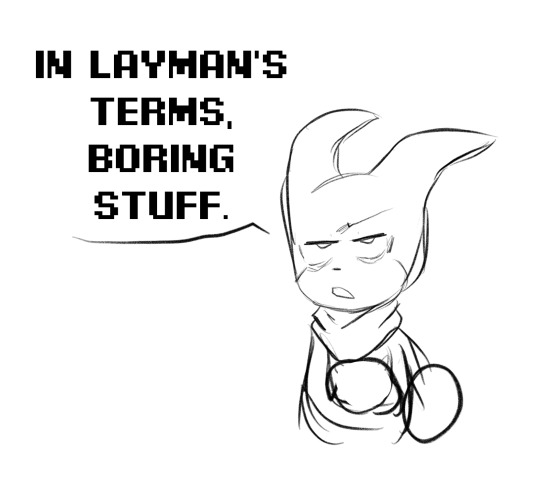
9 notes
·
View notes
Text
Image-to-Text AI
I wanted to discuss image-to-text AI, what it's good at, what limitations it has, and how you can use it to help make accessibility easier.
How It Works
To demonstrate how this works, I'm going to use the image from this post.
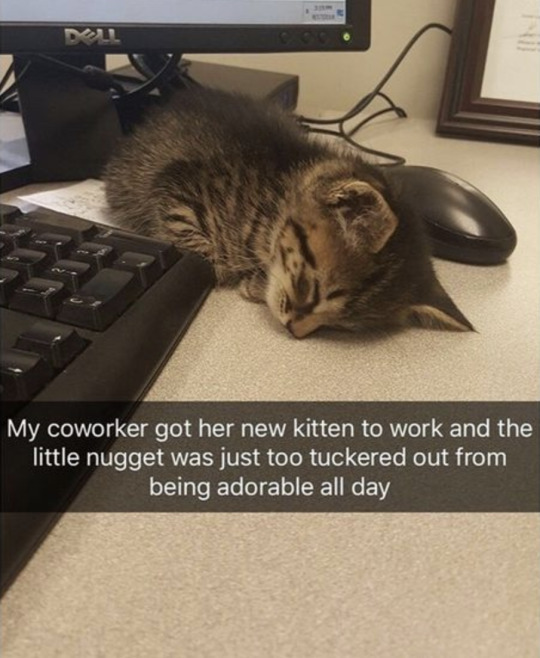
This photo shows a sleeping kitten laying on desk beside a computer, in between the keyboard and the mouse. There is also a corner of a frame of some sort in the upper right corner of the image. Text displays in the center of the image and reads: my coworker got her new kitten to work and the little nugget was just too tuckered out from being adorable all day.
Image-To-Text AI
Image-to-text AI is basically the exact reverse of the famous (or infamous, depending who you ask) text-to-image AI that has taken the world by storm since early 2021. There are a ton of websites for this, some free, many not. For simplicity, I chose to use the image-to-text feature built into Microsoft Word.
When I paste an image into a Word document, the program automatically generates alt text for it using Microsoft's AI. You can view this alt text in the Alt Text panel when editing the document. It will add "Description automatically generated" to the end of the alt text for transparency though, so if you want to keep the alt text it made, make sure to delete that. You can also edit the alt text directly to make it more accurate.
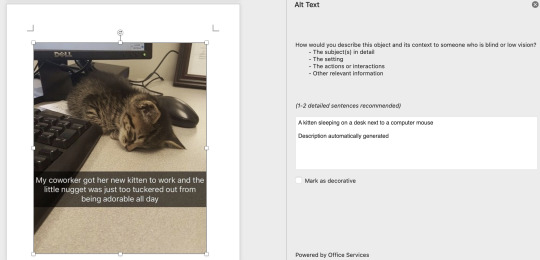
Microsoft's AI came up with "A kitten sleeping on a desk text to a computer mouse." Honestly, not a bad description at all, except it's missing one important thing: the text overlaying the image. This is because Microsoft's image-to-text AI, like many AI of this kind, does not have the ability to transcribe text directly from the image. However, there is a technology that can.
Optical Character Recognition (OCR)
Optical character recognition, or OCR, is a technology that dates back to the 1970s, possibly earlier depending on how you define it. While it's application and accuracy have grown extensively since then, the core function remains the same: recognizing text in an image and transcribing it into a true text format.
I took the photo from the previous section and put it into a Free Online OCR Image To Text Converter.
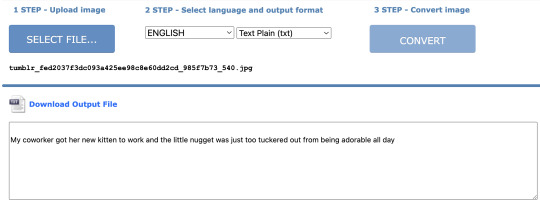
It recognized there was text on the image and transcribed it exactly. Very useful, but it doesn't give us any info about the actual image outside of that.
Limitations
Now, the examples I used above were kind of an ideal situation. AI is not as good with more complex images. For example, I tried putting in a screenshot of a tweet from nym™ (@aretteepls) with a photo of The Sphere at the Venetian Resort in Los Vegas. It is currently displaying a image of SpongeBob's face that fills the entire globe and glows very brightly, turning the night sky's clouds a tinge of yellow. Above the photo, the actual tweet says: The sky is turning yellow because of Spunch Bob.
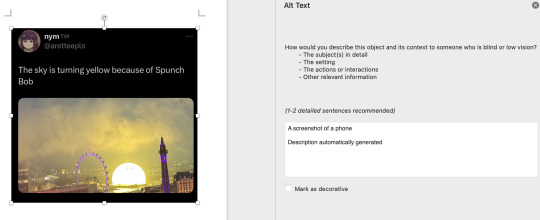
Microsoft's image-to-text AI came up with "A screenshot of a phone." Defintely much less impressive than our first example, but AI is only as good as the data it's trained on. Things like "screenshot of a phone" or "screenshot of a computer" are not uncommon when AI recognizes that you're giving it a screenshot of something on a screen, but can't make heads or tails of what's in it beyond that. And once again, it has no OCR capabilities, so none of the text on the image is transcribed.
But even OCR isn't infallible. The output for this image from that same website I used earlier would be:
nym ,M @aretteepls The sky is turning yellow because of Spunch Bob
The trademark symbol is kind of faint on the screenshot, so the OCR struggled with making that out, transcribing it as "comma M" instead. The less clear the text is visually, the less accurate the OCR output is going to be.
What Do We Do With This?
AI is best when used in conjunction with human aid, and image-to-text AI is non exception. I think the best way forward with this technology is to use generated descriptions as a starting point, not a replacement for human-written ones. And of course, we need to be careful what programs you use to generate the descriptions, especially with art. Programs like Chat GPT have image-to-text functions, but there is no guarantee that an image you upload to it for that purpose will not be used to train it's text-to-image AI as well.
Unfortunately, the more ethically-sourced a training data base for AI is, the more limited it will be compared to it's less-ethically sourced counterparts.
But there are legal precedents being put in place around this, and many text-to-image AI programs now have explicit and detailed terms of service for what you can and can't do with its output, as well as what you should be uploading as input.
So, for the time being, be very cautious with how you use this technology especially when describing others' art. And even with your own art, read through terms and conditions before uploading your work to a website. I think the Microsoft Word one is fairly safe though.
I also think it would be great if someone developed a image-to-text AI that could incorporate OCR to make the end result more informative.
22 notes
·
View notes
Text
Features of Our AI To Human Text Converter
However, not all AI-generated text is fit for human consumption without some level of refinement. That's where the AI To Human Text Converter comes in, a free tool that turns robotic-sounding AI content into natural, human-readable text. Let's dive into the key features that make this tool an indispensable resource for anyone looking to humanize AI-generated text effortlessly.
1. Simple and User-Friendly Interface
One of the standout features of our AI To Human Text Converter is its simple, user-friendly interface. Many people shy away from using complex tools that require a steep learning curve. Fortunately, this converter is designed with ease of use in mind. The interface is intuitive, allowing users to quickly navigate the platform and convert their AI-generated text into human-like content within seconds. There's no need to struggle with confusing menus or spend time learning how to use the tool.
2. Safe and Secure to Use
Safety is paramount when it comes to using online tools, especially for text conversion. AI To Human Text Converter ensures that users' data is protected through secure browsing measures. The website is well-secured, minimizing any risks of data breaches or security threats. Whether you're a content creator, student, or professional, you can confidently use the tool without worrying about jeopardizing your safety.
3. Accurate Conversion of AI-Generated Content to Human-Like Text
The primary feature of the AI To Human Text Converter is its ability to transform AI-generated content into human-readable text. Utilizing advanced algorithms, the tool analyzes the input and produces an output that closely mimics the natural flow of human writing. Whether you're converting AI content for essays, blog posts, or marketing materials, this tool ensures the end result is clear, engaging, and free of robotic phrasing.
4. No Limitations – Unlimited Usage
One of the most attractive features of the AI To Human Text Converter is its unlimited usage policy. Unlike other tools that impose restrictions or require subscriptions after a certain number of conversions, our tool is completely free with no limitations. You can convert as much content as you need, whenever you need it. This makes it an ideal solution for content creators, bloggers, and students with large volumes of AI-generated text to convert.
5. Fast and Efficient Processing
Time is a valuable commodity, and with our AI to human text converter, speed is a top priority. The tool processes your content in seconds, delivering humanized text quickly and efficiently. Whether you have a single paragraph or an entire document to convert, you can trust that the tool will provide results without delays.
6. No Authentication Needed
Another significant advantage of AI To Human Text Converter is that you don’t need to create an account, sign up, or log in. The tool is ready for immediate use, allowing you to convert text as soon as you arrive at the website. This no-authentication feature ensures a hassle-free experience, making it easy for users to get started right away.
Why Choose AI To Human Text Converter?
If you're looking for a reliable and efficient way to humanize your AI-generated content, AI To Human Text Converter is the perfect choice. Here are some key reasons why you should consider using this tool:
Free of Cost: Our tool is completely free to use, with no hidden fees or subscription costs.
Unlimited Use: Convert as much AI content as you need without worrying about restrictions.
No Login Required: Enjoy immediate access to the tool without needing to create an account.
Fast Conversion: Save time with near-instant results that transform AI text into human-like content.
User-Friendly: The intuitive interface makes it easy for anyone to use, even without prior experience.
The AI To Human Text Converter is packed with features that make it an excellent choice for anyone looking to convert AI-generated content into natural, human-readable text. Its simple interface, fast processing, and unlimited usage ensure that you get the best results without any hassle. Plus, with top-notch security measures in place, you can use the tool confidently and safely. Whether you’re a student, content creator, or professional, this tool is designed to meet all your text conversion needs.
Try the AI To Human Text Converter today and experience the difference for yourself!
#AI to human text#AI to human text converter#human-readable text#convert AI-generated content#humanize AI text#free AI to human text converter#secure text converter#AI content converter#unlimited AI text conversion#AI text tool#AI text to human-readable content#convert AI text for essays#convert AI text for blog posts#no login required AI tool#fast AI text conversion#user-friendly AI text converter#free online AI to human text tool#secure browsing AI tool#advanced AI text conversion algorithms#AI content transformation#hassle-free AI content conversion#fast and efficient AI text tool#unlimited usage AI text converter#no subscription AI tool#AI text humanization tool
5 notes
·
View notes
Text
Why You Should Convert AI-Generated Text to Human Text for Better Engagement
AI-generated text has come a long way, streamlining content creation across industries and simplifying writing tasks. However, despite AI’s capabilities, many find that purely AI-generated text often lacks the nuance and relatability of human communication. This gap in engagement has driven demand for AI to human text converters, tools that transform AI-generated text into natural, conversational language.
In this article, we’ll explore the benefits of converting AI-generated text to human text and how this approach can improve engagement across various platforms—from blogs to social media posts.
1. Enhancing Readability and Relatability
AI content, while accurate and informative, can sometimes feel stiff or overly structured. By converting AI-generated text to human-like language, writers can make content more readable and relatable. Humanized content flows better, making it easier for readers to absorb and engage with the information.
Tip: Use tools like AI To Human Text Converter to instantly enhance readability without losing the original meaning, providing a friendly, natural feel to AI content.
2. Building Trust with Authentic Language
Today’s readers are quick to notice content that sounds overly robotic or formulaic. Authenticity builds trust, and content that sounds human is more likely to resonate with audiences. Humanized content reflects empathy, personality, and emotion—all key to forming connections with readers.
Example: For brand marketing, human-like language can give a relatable tone, creating a stronger bond with customers.
3. Improving SEO and User Experience
Engagement metrics like time spent on page, bounce rate, and user interaction are crucial for SEO. Humanized content tends to hold readers’ attention longer, leading to improved SEO performance. A conversational style with strategically placed keywords keeps readers on the page, helping improve overall rankings.
SEO Tip: Tools like AI To Human Text Converter allow for easy keyword integration in humanized content, supporting a natural flow that improves SEO.
4. Increasing Social Media Engagement
Social media thrives on relatable, engaging content. Humanized text is more likely to spark conversation, shares, and comments. When content feels natural, people are more inclined to engage, making humanized AI text ideal for social media marketing and brand voice consistency.
Pro Tip: Whether for captions or blog links, humanized text can make a brand’s social media posts sound more genuine, increasing shares and comments.
5. Better Academic and Professional Use
For assignments, essays, and formal presentations, text that sounds human communicates ideas effectively without seeming detached. AI-generated text may be clear, but converting it to human text adds the depth and comprehension needed in academic and professional contexts.
Application: Many students and professionals now use converters to ensure their writing is both clear and impactful, particularly when communicating complex concepts.
6. Saving Time and Effort
Creating high-quality human-like text from scratch can be time-consuming. AI to human text converters streamline this process, turning rough AI-generated drafts into polished, human-sounding text. This allows writers to focus on creativity and strategy instead of manual rewriting.
Choosing the Right AI to Human Text Converter
When choosing a tool to humanize AI-generated text, consider the following:
Ease of Use: Tools that allow for instant conversion without technical setup are ideal for quick turnarounds.
Customization: Look for converters that let you adjust tone and style for different audiences.
Free Usage: Some tools, like AI To Human Text Converter, offer unlimited conversions for free, making it accessible for various needs.
1 note
·
View note
Text
Benefits Of Conversational AI & How It Works With Examples
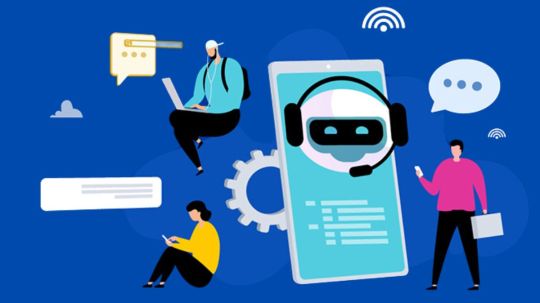
What Is Conversational AI?
Conversational AI mimics human speech. It’s made possible by Google’s foundation models, which underlie new generative AI capabilities, and NLP, which helps computers understand and interpret human language.
How Conversational AI works
Natural language processing (NLP), foundation models, and machine learning (ML) are all used in conversational AI.
Large volumes of speech and text data are used to train conversational AI systems. The machine is trained to comprehend and analyze human language using this data. The machine then engages in normal human interaction using this information. Over time, it improves the quality of its responses by continuously learning from its interactions.
Conversational AI For Customer Service
With IBM Watsonx Assistant, a next-generation conversational AI solution, anyone in your company can easily create generative AI assistants that provide customers with frictionless self-service experiences across all devices and channels, increase employee productivity, and expand your company.
User-friendly: Easy-to-use UI including pre-made themes and a drag-and-drop chat builder.
Out-of-the-box: Unconventional To better comprehend the context of each natural language communication, use large language models, large speech models, intelligent context gathering, and natural language processing and understanding (NLP, NLU).
Retrieval-augmented generation (RAG): It based on your company’s knowledge base, provides conversational responses that are correct, relevant, and current at all times.
Use cases
Watsonx Assistant may be easily set up to accommodate your department’s unique requirements.
Customer service
Strong client support With quick and precise responses, chatbots boost sales while saving contact center funds.
Human resources
All of your employees may save time and have a better work experience with HR automation. Questions can be answered by staff members at any time.
Marketing
With quick, individualized customer service, powerful AI chatbot marketing software lets you increase lead generation and enhance client experiences.
Features
Examine ways to increase production, enhance customer communications, and increase your bottom line.
Artificial Intelligence
Strong Watsonx Large Language Models (LLMs) that are tailored for specific commercial applications.
The Visual Builder
Building generative AI assistants using to user-friendly interface doesn’t require any coding knowledge.
Integrations
Pre-established links with a large number of channels, third-party apps, and corporate systems.
Security
Additional protection to prevent hackers and improper use of consumer information.
Analytics
Comprehensive reports and a strong analytics dashboard to monitor the effectiveness of conversations.
Self-service accessibility
For a consistent client experience, intelligent virtual assistants offer self-service responses and activities during off-peak hours.
Benfits of Conversational AI
Automation may save expenses while boosting output and operational effectiveness.
Conversational AI, for instance, may minimize human error and expenses by automating operations that are presently completed by people. Increase client happiness and engagement by providing a better customer experience.
Conversational AI, for instance, may offer a more engaging and customized experience by remembering client preferences and assisting consumers around-the-clock when human agents are not present.
Conversational AI Examples
Here are some instances of conversational AI technology in action:
Virtual agents that employ generative AI to support voice or text conversations are known as generative AI agents.
Chatbots are frequently utilized in customer care applications to respond to inquiries and offer assistance.
Virtual assistants are frequently voice-activated and compatible with smart speakers and mobile devices.
Software that converts text to speech is used to produce spoken instructions or audiobooks.
Software for speech recognition is used to transcribe phone conversations, lectures, subtitles, and more.
Applications Of Conversational AI
Customer service: Virtual assistants and chatbots may solve problems, respond to frequently asked questions, and offer product details.
E-commerce: Chatbots driven by AI can help customers make judgments about what to buy and propose products.
Healthcare: Virtual health assistants are able to make appointments, check patient health, and offer medical advice.
Education: AI-powered tutors may respond to student inquiries and offer individualized learning experiences.
In summary
The way to communicate with robots might be completely changed by the formidable technology known as conversational AI. Also can use its potential to produce more effective, interesting, and customized experiences if it comprehend its essential elements, advantages, and uses.
Read more on Govindhech.com
#ConversationalAI#AI#NLP#machinelearning#generativeAI#LLM#AIchatbot#News#Technews#Technology#Technologynews#Technologytrends#Govindhtech
3 notes
·
View notes
Text
AI Text Converter To Human Form UK
Cudek AI is a powerful text conversion tool that utilizes artificial intelligence to convert text into human-readable form. This advanced technology has been specifically designed for users in the UK, providing accurate and efficient conversion results. For more information, please visit https://www.cudekai.com/convert-ai-text-to-human
0 notes
Text



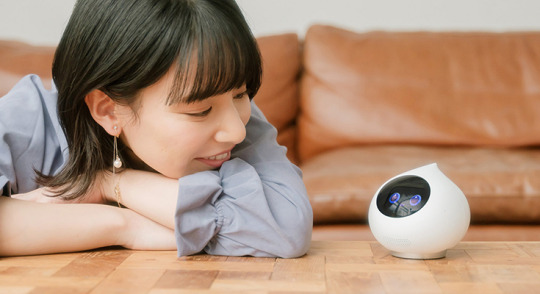

youtube
Romi conversation AI robot, Mixi, Japan (2021). "Romi is a specialized conversation robot that fits snugly in the palm of your hand. Differing from conventional robots equipped with fixed responses, Romi utilizes our cutting-edge proprietary communication AI to keep conversations going, meaning that you can speak to Romi just like a real human. We developed Romi to provide comfort like a pet and understanding like a family member. Possessing a rich range of emotional expression, Romi can share your happiness, sadness, and anger. Romi is sure to brighten your life with over 100 facial expressions and movement patterns and help you bring out the best of every day with over 100 functions such as alarms and reminders." – Providing space and opportunity for communication with Romi, Mixi.
"First, when a person speaks to Romi, Romi converts the voice data into string data via the Google Cloud Speech API. When this string data is sent to the conversation server, the server constructs the answer as text data and returns it to Romi. Finally, Romi uses text-to-speech to convert text into speech and respond to people. Romi uses generative AI in its conversation server to construct answers to people. However, the generative AI model used by Romi is "in a different direction of development'' from models such as GPT-4 … [where] hallucination becomes a major issue. On the other hand, Shinoda's managers tuned Romi based on the idea that even if there were some mistakes, 'as long as it's fun to talk about and the users laugh, that's fine.' This is one of the reasons why we used Stable LM as the base model for our original AI." – an interview with Harumi Shinoda, Vantage Studio Romi Division Development Group Manager, MIXI's conversation robot "Romi" that heals people, AI tuning that emphasizes fun over accuracy.
8 notes
·
View notes